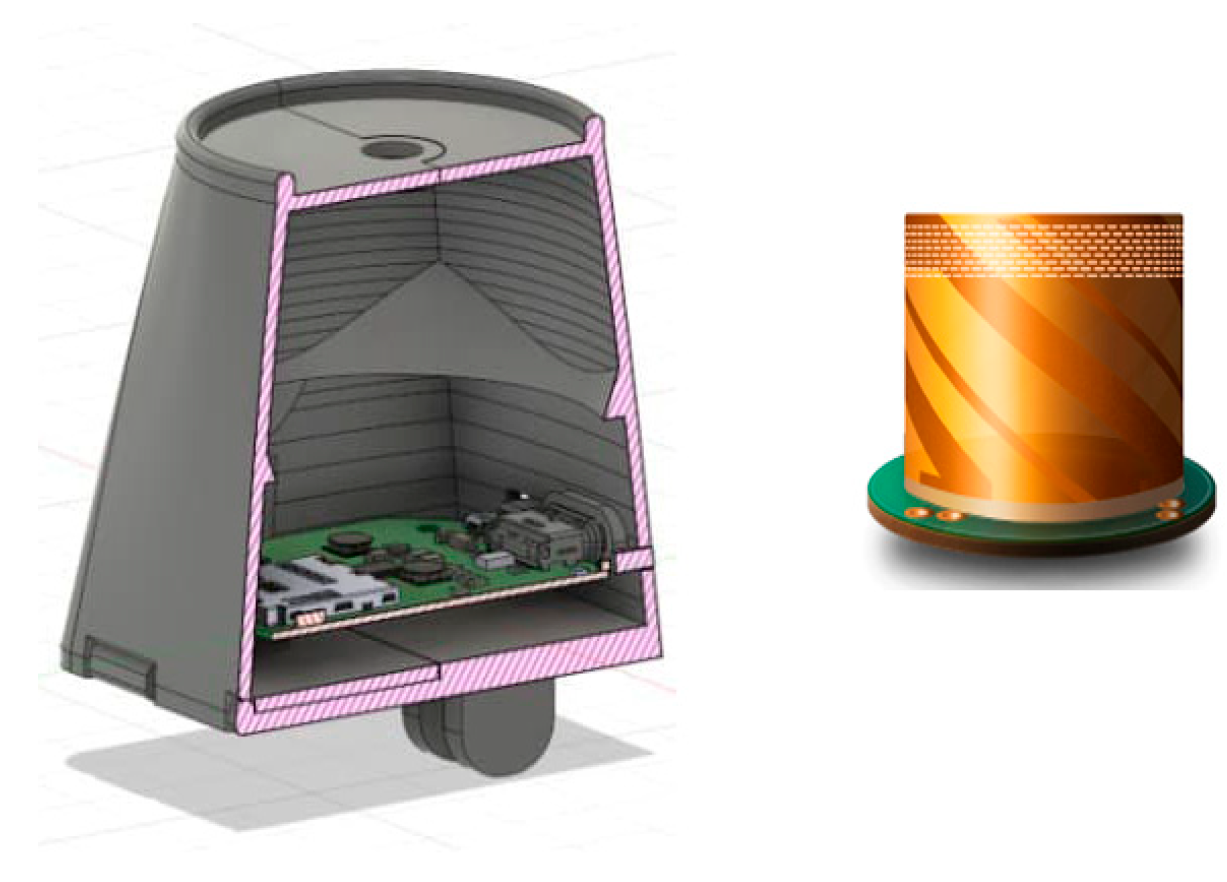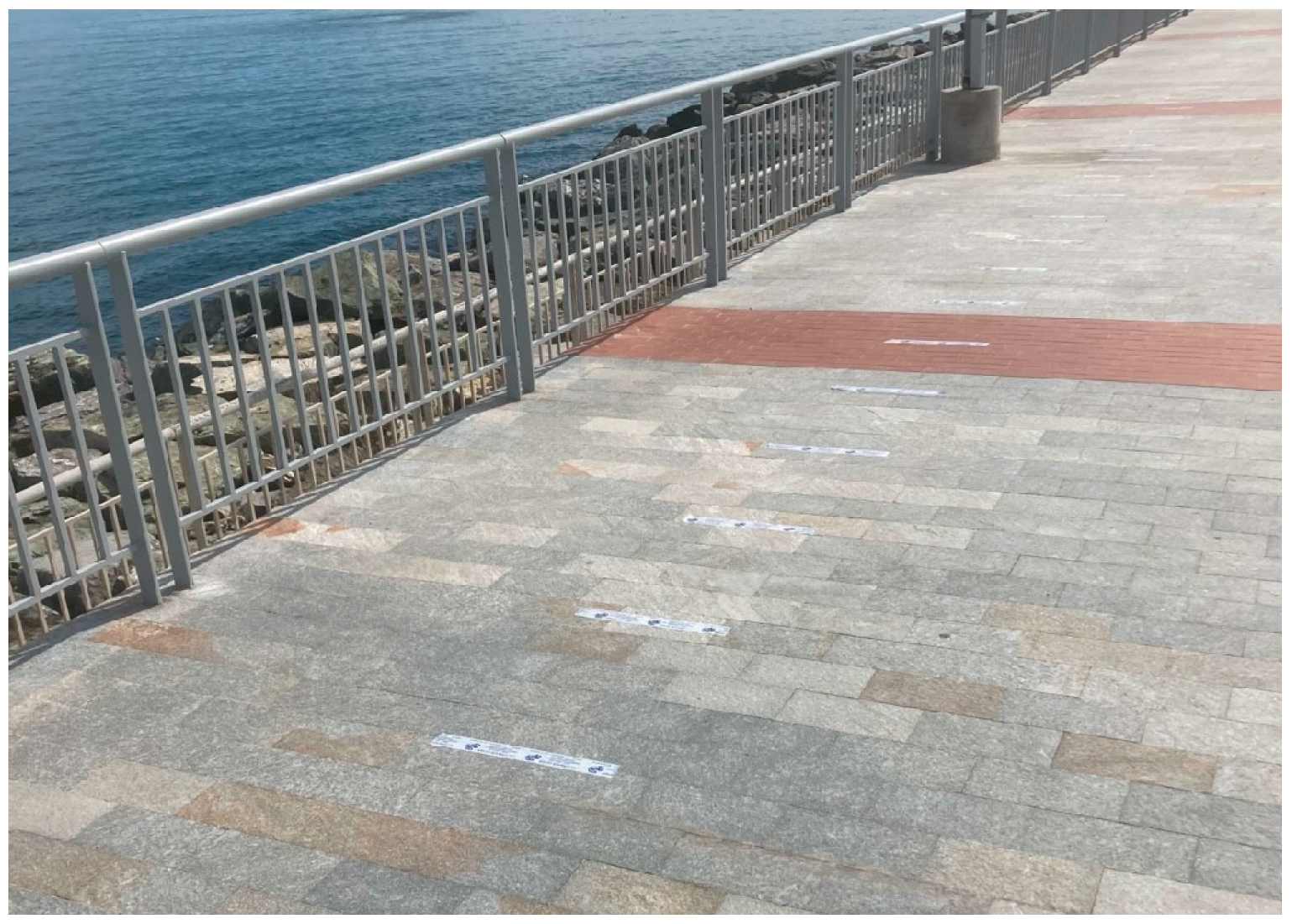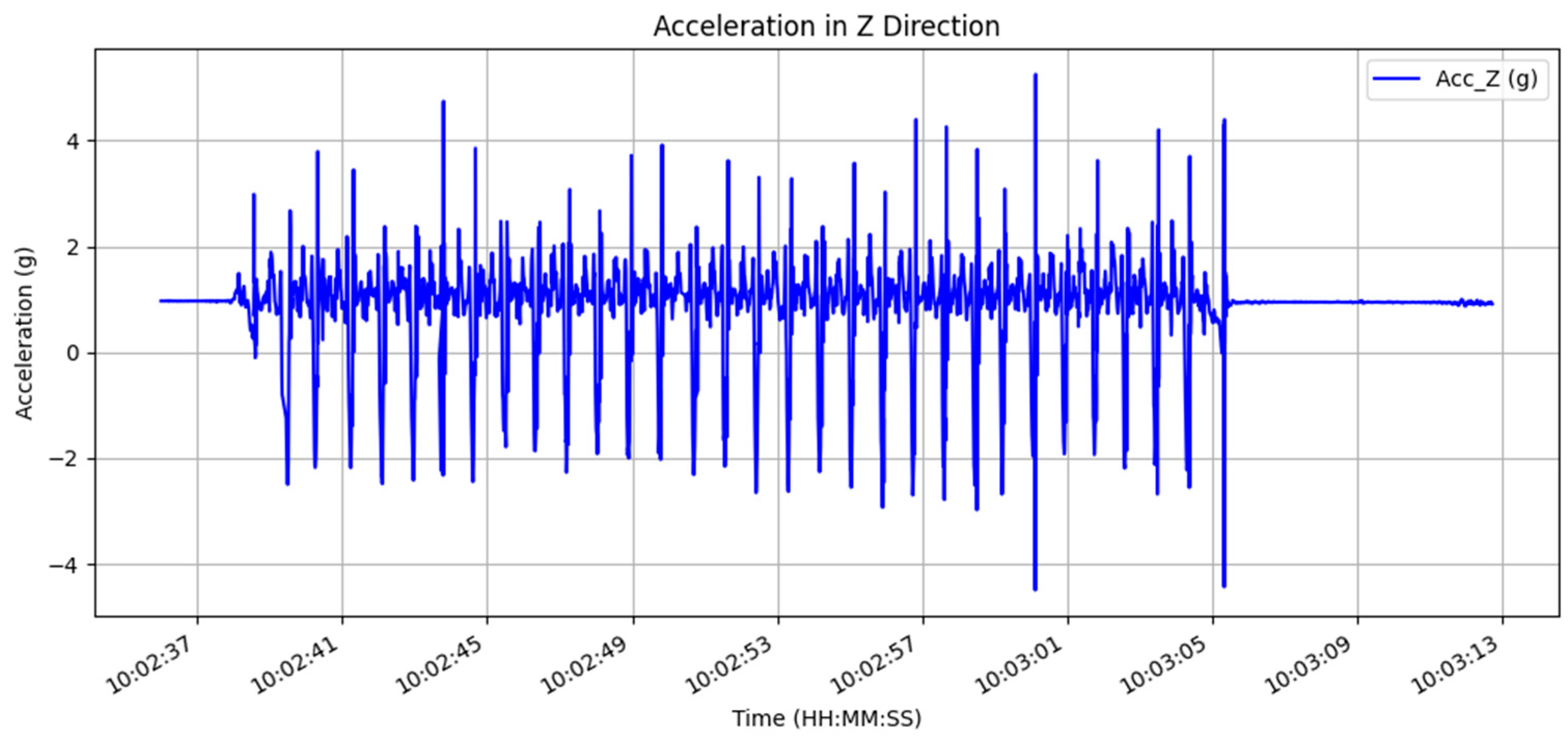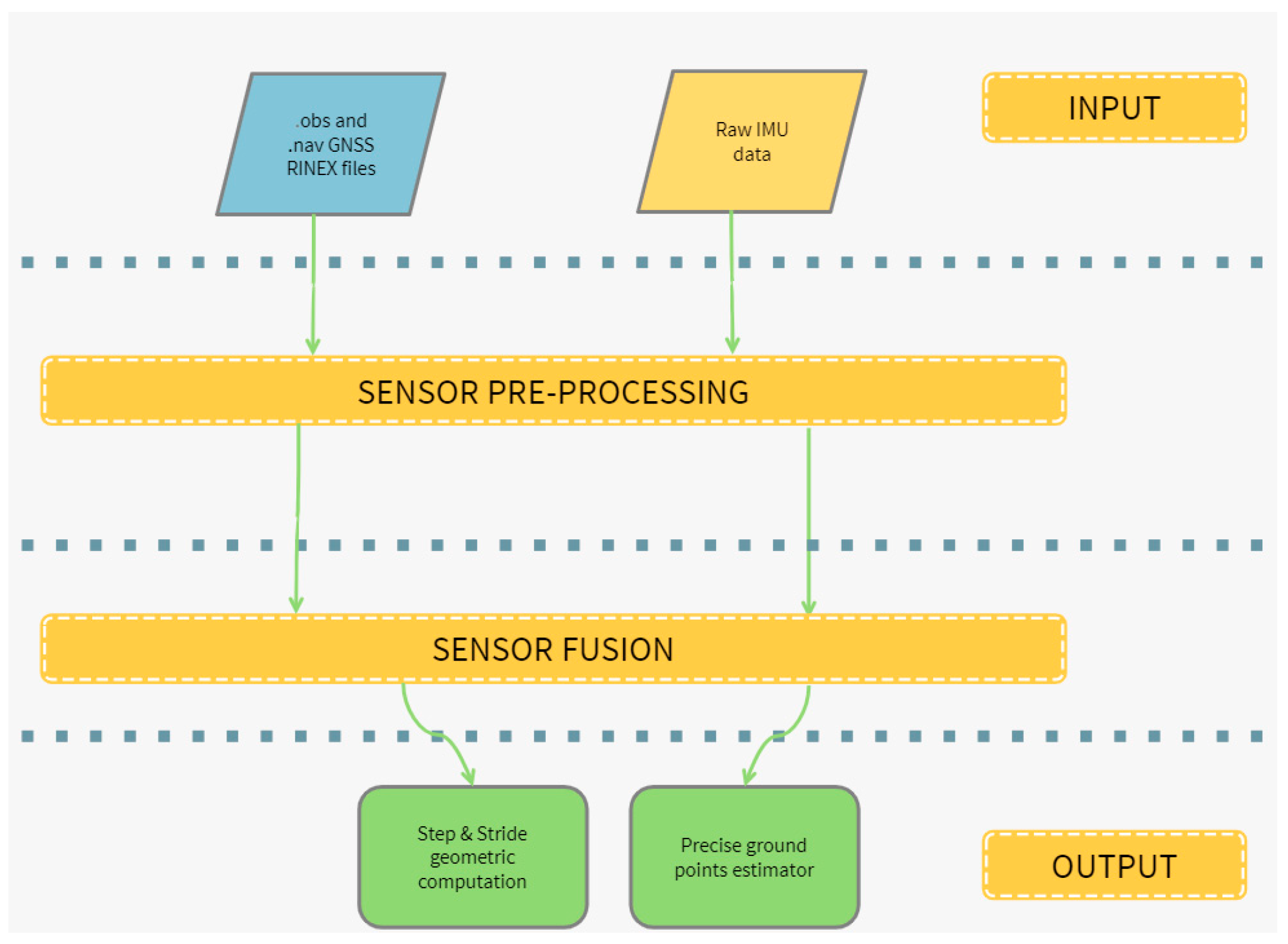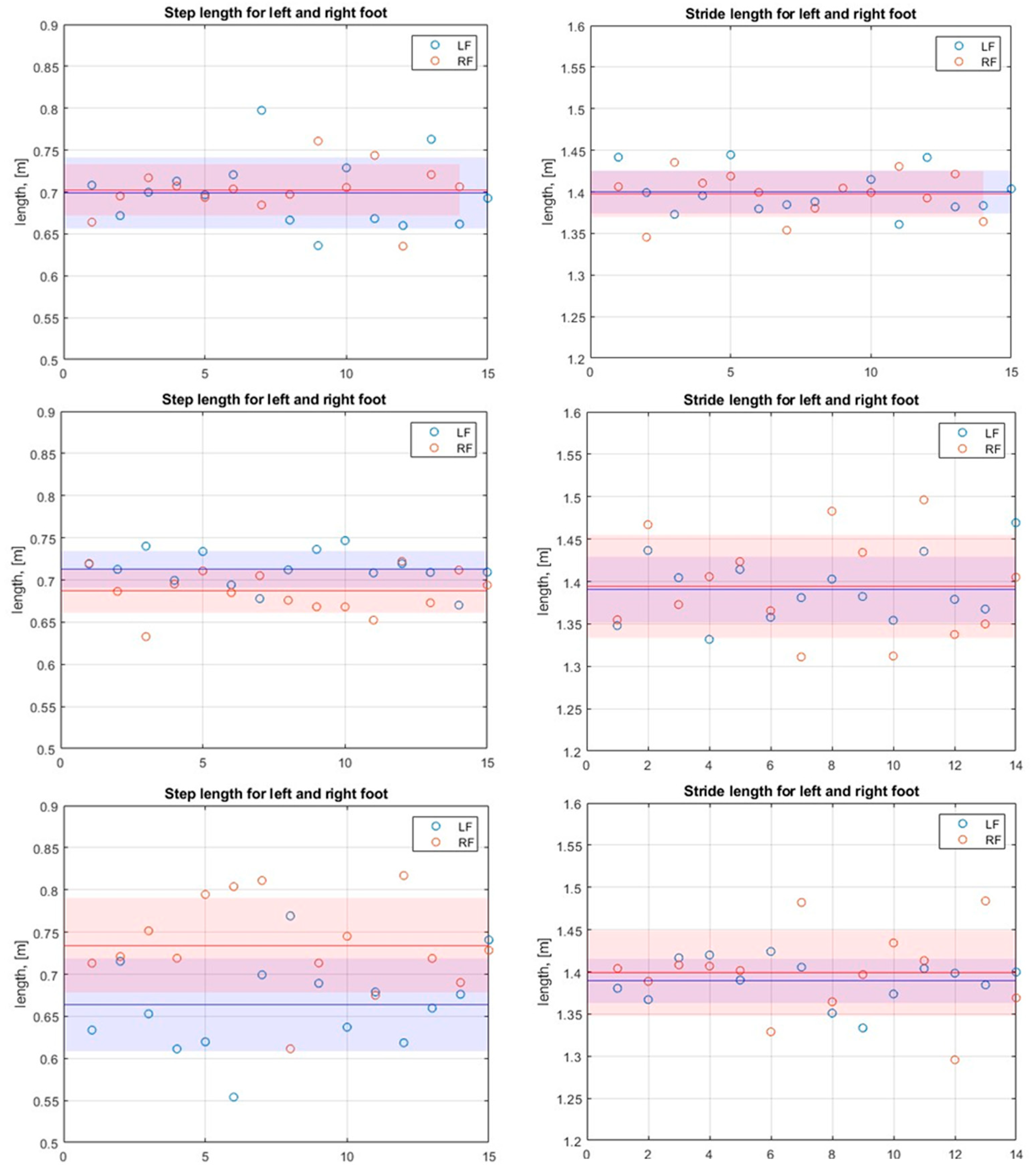1. Introduction
Human motion capture technology, essential in fields such as sports science, rehabilitation, and virtual reality, has traditionally been confined to well-equipped laboratory environments. This limitation is particularly significant as many real-world applications require motion tracking across varied, uncontrolled settings. The integration of GNSS technology with motion capture represents a significant advancement in overcoming these limitations. GNSSs offer a way to achieve high-accuracy location tracking in outdoor environments, enabling the capture of human movements anywhere GNSS signals are available. However, despite the potential of GNSSs, their application in accurate motion capture, especially at the level of foot trajectory tracking, poses challenges due to signal degradation in less-than-ideal conditions and due to the high dynamic to which the receiver can be subject.
Our work focuses on improving outdoor human motion capture by applying it to foot movement using a combination of GNSS receivers and INSs.
Objectives
This study employs the loosely coupled integration [
1] of low-cost GNSS receivers with INSs, using the ZUPT methodology to track and reconstruct foot trajectories. Recognizing the need for an innovative approach to this challenge, our research specifically focuses on assessing the best-performing techniques for GNSS post-processing, investigating PPK [
2], Moving Base, and the mitigation of the signal loss caused by the high jerk to which the receiver is subjected due to the rapid dynamic of foot movement.
2. Materials and Methods
2.1. Testing Setup
For our study, we utilized a compact, integrated GNSS/IMU-based device called “REMOT” (
Figure 1), designed by our team to capture and record satellite and inertial data. The device was equipped with a specially developed helicoidal antenna to optimize satellite signal reception. It was crucial to minimize the device’s size and weight to avoid interfering with natural movement patterns, thereby improving the reliability of our motion analysis.
The IMU sensor used is an MTi-7 (Xsens Technologies B.V., Enschede, The Netherlands) and the GNSS receiver use is an ZED-F9P (u-blox AG, Thalwil, Switzerland).
Three REMOT sensors were attached to the test subject—one on each foot and one on the head—to capture comprehensive movement data from different body points.
2.2. Testing Environment
The experimental trials were conducted in a park, called “
Giardini Govi”, in Genoa, Italy. This location was chosen for its minimal obstructions, providing the clear sky views optimal for GNSS signal reception. The environment was without tall buildings or tree coverage, avoiding potential multipath and signal blockage. A straight line was marked on the ground to define a controlled trajectory for the tests, and 30 lines were marked on this trajectory, at 70 cm each (
Figure 2), to define the points where feet were to be placed during walking.
2.3. Testing Description
We conducted three test sequences, each at different walking speeds—1, 1.5 and 2 steps/second—to assess the system’s performance across different dynamics. Walking speeds were regulated using a metronome to maintain consistent pacing throughout the tests. The recorded data were stored internally and later extracted for post-processing, ensuring that the integration of GNSS and INS data could be analyzed accurately against a pre-surveyed ground truth trajectory and foot contact point.
2.4. GNSS Integration with IMU for Step and Stride Tracking
We decided to use a loosely coupled integration approach to obtain a stable and continuous positioning solution. The advantage of using this method is that the possibility of computing the GNSS solution separately with the aid of software available on the market while implementing the integration algorithm is relatively simple.
2.5. ZUPT Methodology
ZUPT (Zero-Update Position and Time) [
3] is one of the common approaches used in inertial navigation, allowing us to reduce the solution drift and instability due to noisy signals. The ZUPT algorithm is typically implemented as an Extended Kalman filter that, instead of sensor measurements, introduces pseudo-measurements of velocity equal to zero when the device is assumed to be static.
Hence, ZUPT consists of two parts. One of these is a zero-velocity detector, and the other one is an EKF-based inertial navigation algorithm. The purpose of the detector is to determine which time samples correspond to zero velocity based on the raw IMU data. The detection algorithm can be based on numerous approaches, including machine learning. We use a generalized likelihood ratio test (GLRT) called SHOE, which was introduced by [
4,
5].
In the inertial navigation algorithm, detected zero-velocity instances allow us to apply pseudo-measurements at the correct time, forcefully setting the estimated velocity to zero, preventing the solution from exhibiting unstable behavior. Since these measurements are hypothetical and do not come from any kind of sensors, their covariance is set manually based on the estimated uncertainty of the detection algorithm.
ZUPT can be applied together with the LC GNSS corrections if their time is coincident. In such a case, the position correction is applied based on the GNSS positioning data, while the velocity correction is set up in the same way as for the normal ZUPT. One more advantage of such an approach is preventing output deviation during the stance phase in cases of reduced GNSS precision.
2.6. Impact of Walking Speed on GNSS Performance
The impact of walking speed on GNSS performance is a significant factor in our application. GNSSs rely on signals from satellites to calculate positions on Earth, and the dynamics of the user’s speed can influence the accuracy and reliability of these calculations.
In our observations, we noticed a correlation between higher jerk (
Figure 3) and an increased frequency of cycle slips in the GNSS data. Cycle slips refer to the sudden loss of continuous phase measurements, which can disrupt the accuracy of position, velocity, and time calculations derived from GNSS signals. These disruptions are particularly clear during instances of higher acceleration.
Our hypothesis is that as the acceleration of a GNSS-equipped device increases, the integrity of the signal lock is more likely to be compromised, leading to more frequent cycle slips. The cycle slips are due to the Doppler effect because higher accelerations result in a more pronounced Doppler shift in the frequency of the GNSS signals received. This effect must be correctly accounted for in the signal tracking to maintain accuracy in position estimates.
2.7. Mitigating the Impact of Moving Speed
To mitigate the effects of high acceleration and derived Doppler shifts due to foot movement, we explored various settings within the firmware of the Ublox ZED-F9P receiver. By adjusting the dynamic model’s parameter, we tried to optimize the signal tracking loop for the high dynamic conditions experienced.
Our extensive testing across the dynamic models led us to select the “Airborne < 2 g” model, which is specifically engineered for scenarios with higher dynamic range and acceleration capabilities than typical pedestrian movements.
This model supports conditions like the dynamic nature of foot movement during walking, particularly at higher speeds where the foot can experience significant jerk in different directions.
The outcome of implementing the “Airborne < 2 g” model was a marked reduction in cycle slips. These slips can lead to gaps in data, resulting in a loss of accuracy and increased post-processing efforts being required to reconstruct the trajectory accurately.
The “Airborne < 2 g” dynamic model, with its capacity to handle increased horizontal and vertical velocities, demonstrated an improved robustness in signal tracking. As a result, the receiver maintained a more consistent lock on the satellite signals. This improvement had a great impact on our application.
The visual comparison (
Figure 4) shows the superiority of the “Airborne < 2 g” model in maintaining the consistent and accurate tracking of the trajectory. With fewer cycle slips and reduced signal noise, the setting provides a clean dataset. This allows us to extract meaningful gait parameters [
6,
7]. This difference is particularly prominent in the U-D series.
On the other hand, the “Portable” model generates a path that lacks the precision necessary for detailed motion analysis. The erratic nature of this trajectory would result in a misrepresentation of the gait parameters.
Even an analysis of the metrics of the table above (
Table 1) demonstrates the superiority of the Airborne < 2 g model over the others, justifying its selection for our study.
2.8. Data Processing Workflow for GNSS/INS Integration (Figure 5)
Input files: we collect raw GNSS data in .ubx format and IMU data in .mtb format on the device’s internal memory.
Conversion software: these files are extracted and then converted into standardized formats, with GNSS data converted into RINEX. obs and .nav files, and IMU data into text files.
GNSS processing: the RINEX files are processed to generate a precise GNSS positioning file.
Integration and analysis: the GNSS positioning is integrated with IMU data.
Output files: we generate step and stride results and precise ground point estimates as outputs.
3. Results
3.1. Comparison of Different GNSS Data Processing Techniques
In our study, we evaluated two GNSS data processing techniques—Moving Base (MB) and Post-Processing Kinematics (PPK)—to determine their effectiveness in reconstructing accurate foot trajectories. For MB, we used the head-mounted receiver as the base. The comparative analysis focused on several key metrics: fix rate, average number of satellites (Nsat), MAE (Mean Absolute Error) for dtep, MAE (Mean Absolute Error) for stride, average step length, the standard deviation of step length, average stride length, and the standard deviation of stride length.
The results, which are visualized in an accompanying table (
Table 2), indicated that the PPK technique outperformed the MB method.
Specifically, PPK demonstrated a higher fix rate, indicating more reliable signal reception and positional accuracy. In contrast, MB showed a tendency towards Float solutions.
In terms of positional accuracy, the MB method exhibited larger STD values compared to PPK. This suggests that MB was less consistent in its positional estimations, potentially due to its dependency on the dynamic relative positioning between the base and the rover.
The average number of satellites used was lower for MB.
When combined with IMU data, the gait analysis metrics, the average step length, and stride length were captured less accurately by MB, as evidenced by the larger standard deviations in these measurements, suggesting that even the inertial data could not compensate for the weaknesses in the MB GNSS processing in our application and in the test environment.
3.2. Comparison of Impact of Different Walking Speeds on GNSS Receiver Performance
Our findings (
Table 2) indicate a trend: as walking speed increased, the GNSS receiver’s performance declined. The higher-speed condition resulted in the poorest performance metrics.
Despite the trend observed, the system’s capability to describe step and stride characteristics remained within acceptable limits, even at higher speeds.
This can be attributed to several factors: when GNSS data are less precise, the system’s error compensation mechanisms, such as zero-velocity updates (ZUPTs) in the INS integration, contribute to maintaining the accuracy of step and stride measurements, and the integration of GNSS with IMU data helps to smooth out inaccuracies in step and stride detection that might occur due to GNSS errors when using these data alone. This combination allows for a more reliable capture of dynamic gait events, such as heel-strike and toe-off, which define steps and strides.
3.3. Step and Stride Results
With the trajectories obtained, it is possible to compute temporal and spatial parameters related to the gait. Particularly interesting and useful spatial parameters include step and stride length. Stride is the distance between two consequent ground points of the same foot, while step is the distance between the consequent ground points of different feet (left to right or right to left).
Therefore, to compute such distances, it is first needed to identify the stance phases and the ground points based on the trajectory. Of course, the main role here is played by the zero-velocity points determined using the raw IMU data. Nonetheless, it is important to delete wrongly identified points and to unite points that have discontinuities. A ground point is determined by its mean and standard deviation since each measure generates numerous solution points.
Then, step and stride are computed as Euclidean distances between the corresponding points. The fact that during this test ground marks were used for reference helped to ensure that the step length were around 0.7 m and the stride length were approximately equal to 1.4 m, that is, twice the step length.
Indeed, it can be seen from the results (
Figure 6) (
Table 2) that the values are close to the expectations, and the standard deviation does not exceed a few centimeters, which can be simply explained by a normal imprecision, caused by putting the foot on top of the marker. Also, the standard deviation for step and stride length grows slightly with the growing walking speed, which is explained by less precise positioning.
4. Discussion
4.1. Summary
The integration of GNSSs with INSs, augmented by the ZUPT methodology, has shown promising results for outdoor motion tracking. By coupling these systems, positional inaccuracies commonly associated with each are mitigated, as GNSSs provide extensive coverage while INSs fill in data gaps when GNSS signals are degraded. Notably, foot movements exhibit very high dynamics during fast walking, presenting challenges to GNSSs due to fast acceleration shifts.
These dynamics increase the chances of cycle slips and Doppler effects. Using the “Airborne < 2 g” dynamic model reduced these errors. ZUPT has also proven effective in reducing drift and error accumulation, enabling accurate step and stride measurements.
4.2. Future Directions
Future research should focus on the tightly coupled and ultra-tightly coupled integration of GNSSs and Inertial Navigation Systems (INSs), which involves deeper data fusion, allowing for the improved correction of errors and robust handling of GNSS signal degradation.
We should also explore the real-time application of the technology, opening the door to practical use cases in other fields where real-time feedback would be preferred.
